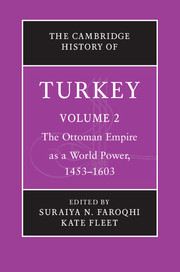Book contents
- Frontmatter
- Contents
- List of Illustrations
- List of Maps
- List of Contributors
- Chronology
- A note on transliteration
- Maps
- 1 Introduction
- Part I An Expanding Empire
- 2 The Ottomans, 1451–1603
- 3 Ottoman expansion in Europe, ca. 1453–1606
- 4 Ottoman expansion in the East
- 5 Ottoman expansion in the Mediterranean
- 6 Ottoman expansion in the Red Sea
- Part II Government, Economic Life and Society
- Part III Culture and the Arts
- Glossary
- Bibliography
- Index
- References
3 - Ottoman expansion in Europe, ca. 1453–1606
from Part I - An Expanding Empire
Published online by Cambridge University Press: 05 July 2013
- Frontmatter
- Contents
- List of Illustrations
- List of Maps
- List of Contributors
- Chronology
- A note on transliteration
- Maps
- 1 Introduction
- Part I An Expanding Empire
- 2 The Ottomans, 1451–1603
- 3 Ottoman expansion in Europe, ca. 1453–1606
- 4 Ottoman expansion in the East
- 5 Ottoman expansion in the Mediterranean
- 6 Ottoman expansion in the Red Sea
- Part II Government, Economic Life and Society
- Part III Culture and the Arts
- Glossary
- Bibliography
- Index
- References
Summary
The Ottoman Empire is often imagined in terms of major conquests and major reigns, those that are expansive. Thus, the sixteenth century, in the context of Ottoman “activity” in Europe, tends to be framed by the conquest of Constantinople in 1453 and by the conclusion of the “long” Ottoman–Habsburg war of 1593–1606, respectively, or by the reigns of Mehmed II (r. 1444–6, 1451–81) and Murad III (r. 1574–95), with that of Süleyman the Lawgiver (1520–66) as a focal point of consolidation and triumph. The sixteenth century is also circumscribed by the emergence of the Shi’ite Shah Isma‘il Safavi in Iran in 1501 and by the launching of the “long” Ottoman war of 1603–18 against the Safavid regime. That state problematised Ottoman expansion in Europe through the creation of an aggressive enemy on the Ottoman eastern borders, one which actively recruited Ottoman subordinates, especially in the mountainous areas of eastern Anatolia, fought the Ottomans for control of Iraq and the outlets to the Persian Gulf, and rhetorically challenged the sultans’ claims to sacred hegemony in the Islamic world. The existence of a powerful Muslim challenger in Iran meant that Ottoman military investment in Europe was always subject to the demands of the eastern frontier. Another important idea affecting the conceptualisation of the sixteenth century is the notion of a resurgence and re-configuration of European powers in the Mediterranean associated with the Christian forces’ victory at the naval battle of Lepanto in 1571 and the emergence of the English as a rising commercial force in the Levant. That re-configuration in the last three decades of the century presented both limitations and opportunities for the Ottomans. While such periods and events suggest an outline of Ottoman expansion in Europe, as with all such historical markers, they do not suffice to convey the continuities, processes and universal rhetorics which transcend the constraints of reigns, state-formation, battles and periods of war.
- Type
- Chapter
- Information
- The Cambridge History of Turkey , pp. 44 - 73Publisher: Cambridge University PressPrint publication year: 2012
References
- 2
- Cited by



